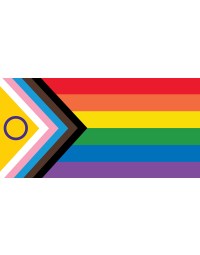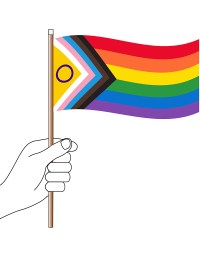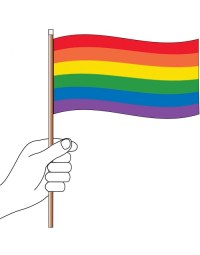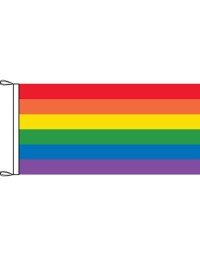Pride Flags: Symbolism & History

Flags have always played a powerful role in representing identities, movements, and communities. At Flagworld, we offer a wide range of high-quality pride flags that represent the LGBTQ+ community. Each flag carries unique symbolism and history. Let's explore the meaning behind some of the pride flags available on our website.
The Rainbow Pride Flag, also known as the Gay Pride Flag or LGBT Pride Flag, is an iconic symbol of the LGBTQ+ community. Originally created in 1978 by artists Gilbert Baker, Lynn Segerblom, James McNamara, and other activists, its vibrant colours represent the diversity of the LGBTQ+ community and the spectrum of human sexuality and gender. The design has undergone several revisions and variations, with the 6-stripe variation currently being the most common.
Designed by Michael Page in 1998, the Bisexual Pride Flag aims to increase visibility for the bisexual community. It consists of three horizontal stripes: pink representing homosexuality, blue representing heterosexuality, and a purple stripe in the middle. The purple stripe, formed as an overlap of the pink and blue stripes, represents attraction regardless of sex or gender.
The Transgender Pride Flag, created in 1999 by transgender woman Monica Helms, represents the transgender community, whose gender identity differs from the sex they were assigned at birth. The pink and blue stripes represent the traditional colours for baby girls and boys, with the white stripe in the centre representing those who are transitioning between those genders or who do not identify with either.
The Asexual Pride Flag, established in 2010 through a community effort, represents asexuality, which is the lack of sexual attraction or low or absent desire for sexual activity. Its black stripe symbolizes asexuality, grey represents grey-asexuality (the spectrum between sexuality and asexuality) and demisexuality (sexual attraction only experienced secondarily, rather than based on physical qualities), white represents allies, and purple represents the asexual community. This flag celebrates the diversity of human experiences and relationships.
The Pansexual Pride Flag, introduced in 2010 by Jasper V., promotes visibility and recognition of the pansexual community. Pansexuality encompasses sexual or romantic attraction to individuals regardless of their gender. The flag features three stripes: cyan represents attraction to men, pink represents attraction to women, and yellow represents attraction to non-binary individuals.
Gender Queer Pride Flag (2011)
The Gender Queer Pride Flag, designed in 2011 by Marilyn Roxie, represents the genderqueer community. Genderqueer individuals identify as not exclusively masculine or feminine, existing outside the gender binary. The flag incorporates lavender (a mixture of blue and pink, traditional colours for baby boys and girls), white (representing an agender identity), and dark green (the inverse of lavender, signifying identities beyond the traditional gender binary).
Gender Fluid Pride Flag (2012)
The Gender Fluid Pride Flag, created in 2012 by JJ Poole, represents the gender fluid community. Gender fluid individuals have a gender identity or expression that is not fixed and may encompass one or multiple genders, or none at all. The flag consists of pink (representing femininity), blue (representing masculinity), purple (combining both), black (signifying the absence of gender), and white (representing all genders).
The Intersex Pride Flag, designed by Morgan Carpenter of Intersex Human Rights Australia in 2013, represents individuals born with sex characteristics that do not align with typical binary notions of male or female bodies. The flag features yellow and purple colours, which were considered free from gender associations. The circle is "unbroken and unornamented, symbolising wholeness and completeness, and our potentialities.
The Aromantic Pride Flag, created by Cameron Whimsy in 2014, symbolises the aromantic community: those who experience little to no romantic attraction. The flag's stripes represent aromanticism, the aromantic spectrum, aesthetic attraction, greyromantic (romantic attraction rarely or only weakly experienced) and demiromantic people (romantic attraction only experienced after a strong emotional bond has been formed), and the overall spectrum of human sexuality.
Rainbow Flag for People of Colour (2017)
Designed in 2017 by marketing firm Tierney, this variation of the Rainbow Pride Flag adds black and brown stripes to the top of the standard six-colour flag. The additional stripes acknowledge and address issues faced by people of colour within the LGBTQ+ community.
The Progress Pride Flag, designed in 2018 by Daniel Quasar, merges elements from the Rainbow Pride Flag, the Transgender Pride Flag, and the Rainbow Flag for People of Colour. It represents the LGBTQ+ community's progress and highlights the inclusion of marginalised individuals, specifically people of colour and transgender people. The flag's arrow pointing to the right symbolises forward movement and ongoing progress.
Intersex Inclusive Progress Pride Flag (2021)
The Intersex Inclusive Progress Pride Flag, designed in 2021 by Valentino Vecchietti, combines the Progress Pride Flag with the Intersex Pride Flag. This inclusive flag represents the LGBTQI+ community, highlighting marginalised individuals of colour, transgender people, and intersex people. The arrow pointing to the right signifies the continuous journey towards progress and inclusion.
At Flagworld, we provide high-quality pride flags that honour the long history of symbolism outlined above. Our flags are meticulously crafted and made in Melbourne, ensuring the finest quality and attention to detail. If you're looking for a specific design, size, or finish that is not listed on our website, feel free to get in touch with us, and we'll be more than happy to accommodate your needs.
Shop high-quality Pride Flags made in Melbourne by Flagworld. If you need a design, size, or finish not listed on our website, get in touch, and we can make it happen!
Flags have always played a powerful role in representing identities, movements, and communities. At Flagworld, we offer a wide range of high-quality pride flags that represent the LGBTQ+ community. Each flag carries unique symbolism and history. Let's explore the meaning behind some of the pride flags available on our website.
The Rainbow Pride Flag, also known as the Gay Pride Flag or LGBT Pride Flag, is an iconic symbol of the LGBTQ+ community. Originally created in 1978 by artists Gilbert Baker, Lynn Segerblom, James McNamara, and other activists, its vibrant colours represent the diversity of the LGBTQ+ community and the spectrum of human sexuality and gender. The design has undergone several revisions and variations, with the 6-stripe variation currently being the most common.
Designed by Michael Page in 1998, the Bisexual Pride Flag aims to increase visibility for the bisexual community. It consists of three horizontal stripes: pink representing homosexuality, blue representing heterosexuality, and a purple stripe in the middle. The purple stripe, formed as an overlap of the pink and blue stripes, represents attraction regardless of sex or gender.
The Transgender Pride Flag, created in 1999 by transgender woman Monica Helms, represents the transgender community, whose gender identity differs from the sex they were assigned at birth. The pink and blue stripes represent the traditional colours for baby girls and boys, with the white stripe in the centre representing those who are transitioning between those genders or who do not identify with either.
The Asexual Pride Flag, established in 2010 through a community effort, represents asexuality, which is the lack of sexual attraction or low or absent desire for sexual activity. Its black stripe symbolizes asexuality, grey represents grey-asexuality (the spectrum between sexuality and asexuality) and demisexuality (sexual attraction only experienced secondarily, rather than based on physical qualities), white represents allies, and purple represents the asexual community. This flag celebrates the diversity of human experiences and relationships.
The Pansexual Pride Flag, introduced in 2010 by Jasper V., promotes visibility and recognition of the pansexual community. Pansexuality encompasses sexual or romantic attraction to individuals regardless of their gender. The flag features three stripes: cyan represents attraction to men, pink represents attraction to women, and yellow represents attraction to non-binary individuals.
Gender Queer Pride Flag (2011)
The Gender Queer Pride Flag, designed in 2011 by Marilyn Roxie, represents the genderqueer community. Genderqueer individuals identify as not exclusively masculine or feminine, existing outside the gender binary. The flag incorporates lavender (a mixture of blue and pink, traditional colours for baby boys and girls), white (representing an agender identity), and dark green (the inverse of lavender, signifying identities beyond the traditional gender binary).
Gender Fluid Pride Flag (2012)
The Gender Fluid Pride Flag, created in 2012 by JJ Poole, represents the gender fluid community. Gender fluid individuals have a gender identity or expression that is not fixed and may encompass one or multiple genders, or none at all. The flag consists of pink (representing femininity), blue (representing masculinity), purple (combining both), black (signifying the absence of gender), and white (representing all genders).
The Intersex Pride Flag, designed by Morgan Carpenter of Intersex Human Rights Australia in 2013, represents individuals born with sex characteristics that do not align with typical binary notions of male or female bodies. The flag features yellow and purple colours, which were considered free from gender associations. The circle is "unbroken and unornamented, symbolising wholeness and completeness, and our potentialities.
The Aromantic Pride Flag, created by Cameron Whimsy in 2014, symbolises the aromantic community: those who experience little to no romantic attraction. The flag's stripes represent aromanticism, the aromantic spectrum, aesthetic attraction, greyromantic (romantic attraction rarely or only weakly experienced) and demiromantic people (romantic attraction only experienced after a strong emotional bond has been formed), and the overall spectrum of human sexuality.
Rainbow Flag for People of Colour (2017)
Designed in 2017 by marketing firm Tierney, this variation of the Rainbow Pride Flag adds black and brown stripes to the top of the standard six-colour flag. The additional stripes acknowledge and address issues faced by people of colour within the LGBTQ+ community.
The Progress Pride Flag, designed in 2018 by Daniel Quasar, merges elements from the Rainbow Pride Flag, the Transgender Pride Flag, and the Rainbow Flag for People of Colour. It represents the LGBTQ+ community's progress and highlights the inclusion of marginalised individuals, specifically people of colour and transgender people. The flag's arrow pointing to the right symbolises forward movement and ongoing progress.
Intersex Inclusive Progress Pride Flag (2021)
The Intersex Inclusive Progress Pride Flag, designed in 2021 by Valentino Vecchietti, combines the Progress Pride Flag with the Intersex Pride Flag. This inclusive flag represents the LGBTQI+ community, highlighting marginalised individuals of colour, transgender people, and intersex people. The arrow pointing to the right signifies the continuous journey towards progress and inclusion.
At Flagworld, we provide high-quality pride flags that honour the long history of symbolism outlined above. Our flags are meticulously crafted and made in Melbourne, ensuring the finest quality and attention to detail. If you're looking for a specific design, size, or finish that is not listed on our website, feel free to get in touch with us, and we'll be more than happy to accommodate your needs.
Shop high-quality Pride Flags made in Melbourne by Flagworld. If you need a design, size, or finish not listed on our website, get in touch, and we can make it happen!















